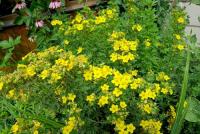Silverweed shrub red ice. Mottled Shrub
It occurs in natural conditions in similar environmental conditions with Lapatka Daurian, but has a wider range, capturing the forest-steppe and forest zones of Western Europe and Russia, Central Asia and the Caucasus. Protected in reserves. It grows on scree, stony slopes, in rock crevices on pebbles, forms thickets.
Hardy, heavily branched shrub, reaching a height of 1.5 m, with gray or red-brown, exfoliating bark; with a thick hemispherical crown. The leaves of cinquefoil shrub consist of five, more rarely from three to seven, leaflets, first soft green, then green with a silvery shade. The leaflets are lanceolate-ovate or lanceolate, entire, 3 cm long and about 1 cm wide, at the apex bluntly or shortly pointed, sometimes with curled edges, hairy on both sides. Stipules of cinquefoil shrub membranous, fused with petioles, ovate-lanceolate or simply ovate. Its flowers are golden-yellow, with five rounded petals, solitary, wide-open, as if scattered over the surface of a bush above the foliage, axillary or in loose apical racemes, or shields. In each flower there are 30 stamens, this makes the middle of the flower fluffy. In cinquefoil shrub fruits are collective seeds, after ripening, the shrub is covered with brown, with thin hairs “buttons”, this does not spoil the appearance either in spring or in autumn.
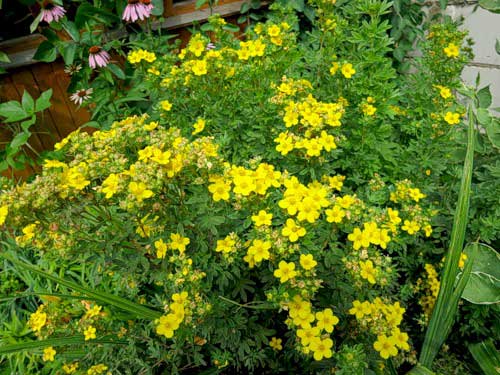
In Russia, shrubs are cultivated from the Arctic to the southern borders. Mottled shrub winter-hardy. Drought-resistant, however, does not tolerate dry air. Prefers rich, moderately wet soils. It is photophilous, although it makes half-shade. The young bush of a silverweed shrub grows quickly, but over the years its growth slows down. In our conditions, the shrub grows to a height of 1.3 m. The cinquefoil is shrubby - the plant is skoroplodnoe, when propagated by cuttings, it begins to bloom and bear fruit from 2 years. The shrub blooms in June and blooms until October; one shrub of a silverweed shrub can bloom for more than two months. Its fruits ripen in August or September. The shoots of cinquefoil shrubs are woody by 100%, winter hardiness is very high. It blooms annually. Propagated by seed and vegetatively. In order to preserve the decorative effect every 5 years it is necessary to carry out anti-aging pruning. Shrubby cinquefoil is recommended for creating group and single plantings.
In our climate, resistant from low varieties with yellow-orange color of flowers: 'Beesii', 'Coronaitin Triumph', 'Donard Gold ",' Dart's Golddigger ',' Dakota Sunrise ',' Goldstar ',' Goldfinger ',' Goldteppich ', 'Jolina', 'Reisenberg', 'Longacre' and varieties of 'Beanii', 'Farrer's White', 'Abbotswood', 'Rhodocalyx' with white flowers.
Of tall (more than 1 m) winter-hardy varieties ‘Kathrine Dykes and‘ Elizabeth with yellow flowers.
The following varieties have the silver-gray foliage: ‘Beesii‘, ‘Goldfinger‘, ‘Goldteppich,‘ Dart’s Golddigger, ‘Kathrine Dykes‘, ‘Longacre‘.
Compact and low varieties with yellow flowers 'Farreri' and similar to them 'Kobold', 'Klondike' with light green leaves, 'Pyrenaica', 'Parvifolia', 'Red Ace' with copper-yellow flowers and close “Gold Drop”, “Red Robbin”, and also “Tangerine” with orange-to-golden-yellow flowers and “Sunset” similar to it. This group includes purple gloves with cream and white flowers (‘Eastleigh Cream) and pink‘ Royal Flush ‘,‘ Daydawn ‘,‘ Pretty Polly ‘,‘ Princess ‘.
Due to the felt downiness, the gray and blue-green leaves have the varieties ro Primrose Beauty, ‘Parvifolia‘, ‘Pyrenaica‘.
From high (more than 1 m) bushes, in cold winters, varieties with creamy and pale yellow flowers can freeze out: ‘Vilmoriniana‘, ‘Ochroleuca‘, ‘William Purdom‘, which are also characterized by a grayish-green foliage.
Description of the most popular varieties of Potentilla shrub:
Silverweed shrub "Abbotswood" ("Abbotswood") - low bush 1 m tall. It has a cushion-shaped, dense crown. Potentilla leaves "Abbotswood" light green.

Its flowers are 2.5 cm in diameter, white, gathered in small or single brushes. Potentilla blooms "Abbotswood" from June to October. It is one of the best varieties. Recommended for planting groups in rock gardens and for the creation of borders.
Silverweed shrub "Gilford Cream" ("Gilford Cream") - 60 cm high. The diameter of the crown of 1 m, widely prostrate bush, densely leafy. The leaves of Potentilla "Guilford Cream" are bright green.

The flowers are creamy-white, large. It blooms from May to September.
Silverweed shrub "Goldfinger" ("Goldfinger") - a low, dense shrub in height of 1.5 m, with a cushion crown. Potentilla Goldfinger leaves are dark green.
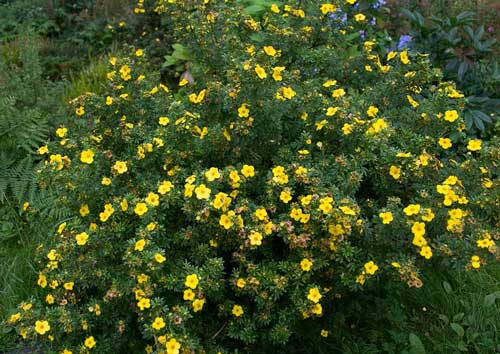
Its flowers are yellow, large 5 cm in diameter. Begins to bloom in June and until October. Abundantly flowering variety.
Silverweed shrub "Daydawn" ("Daydawn")- shrub 70 cm high, and crown width 1.2 m.
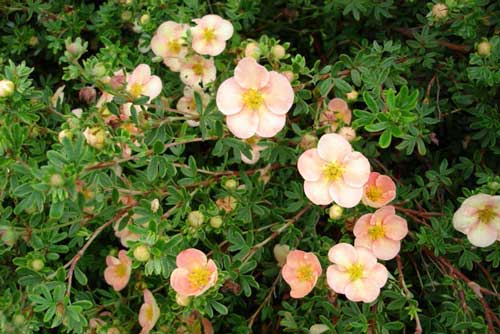
Outside, flowers with an orange tint. Potentilla blooms "Daidaun" from May to October.
Silverweed shrub "Kobold" ("Kobold") - low bush, bush diameter 1.2 m, height 0.5 m, crown dense, pillow. Its leaves are light green.
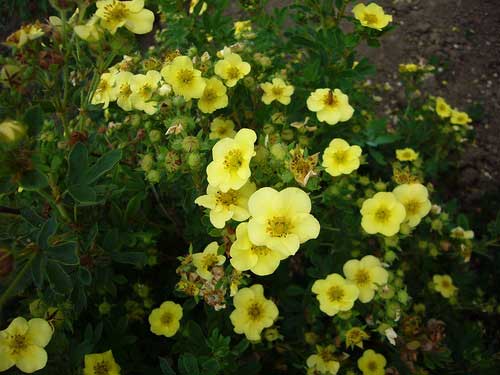
Potentilla Kobold flowers are light yellow, opening in June-July and remain on bushes until September, depending on the care of the shrubs. The Kobold silverweed grows faster than, for example, other varieties, therefore, in order to keep the crown in a decorative form, it must be regularly cut.
Silverweed shrub "Pink Queen" ("Pink Queen") - a bush with a height of 80 cm. The flowering of the purple quail "Pink Queen" begins from June to September.
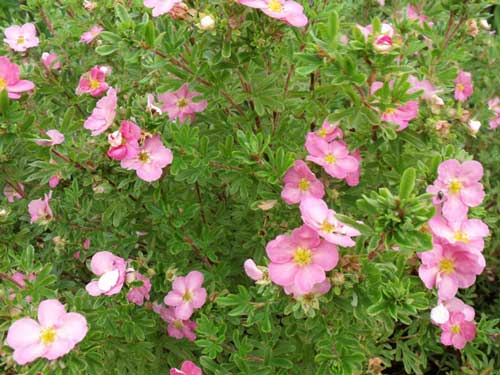
Potentilla bush "Primrose Beauty" ("Primrose Beauty") - a spherical bush, the diameter of the crown and a height of 1.2 m. The Potenza paprochka Primrose Beauty flowers are small, light yellow, numerous.

It blooms from June to September.
Potentilla shrubby "Princess" ("Princess")- shrub height 80 cm. Crown pillow, dense 1 m in diameter. Potentilla leaves "Princess" dark green. Her flowers are 3.5 cm. It blooms in May and ends in October.
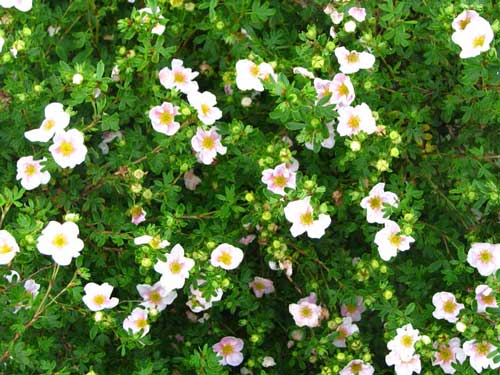
Silverweed shrub "Red Robin" ("Red Robin")- 60 cm high. Red Red Robin Potentilla flowers are dark red. Blossom starts in July.

Silverweed shrub "Royal Flush" ("Royal Flush") - 50 cm tall, crown diameter 1 m. Undersized variety with boggy shoots. Potentilla flowers "Royal Flush" first red, then dark pink.
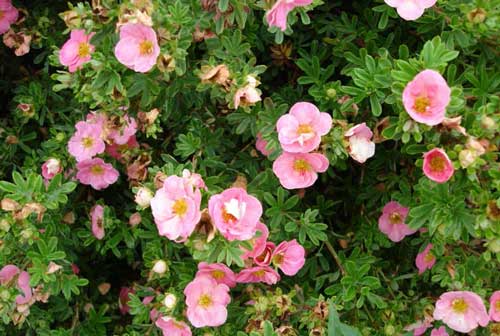
Blossoms in June, ends in October. Very attractive autumn coloring leaves.
Silverweed shrub "Tangerine" ("Tangerine") - thick low shrub with a rounded crown. The shoots are gentle. Potentilla leaves "Tangerine" are gray-green.
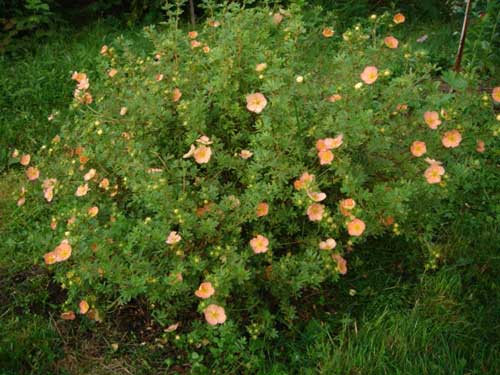
The edges of the petals of this Potentilla are orange, in the center of the plants in the sun they are yellow-golden, in those growing in the shade they are copper-orange. Potentilla blooms "Tangerine" in June-September.
Potentilla shrub "Hopley Orange" ("Hopley Orange") - shrub height 50 cm, crown width about 1 m. Its flowers are dark orange.

Flowering begins in May, ends in late September.
Silverweed shrub "Red Ace" ("Red Ace") - a bush with gentle creeping shoots, 65 cm high and a crown width of about 1.2 m. Its leaves are light green. The first spring flowers are orange-red, in summer they are orange-yellow. It blooms from June to September, sometimes until October.
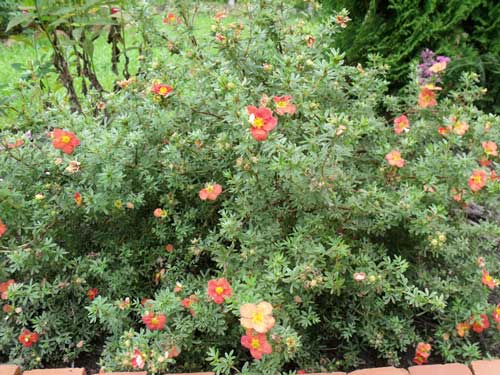
Potentilla is a perennial, rarely an annual plant of the Pink family. Potentilla genus is the most numerous in terms of the number of species - there are about 325 of them, including grassy, semi-shrub and shrub. And each of the species can decorate a corner of the garden or become a central element of the landscape composition, especially since it is easy to care for them.
Botanical description
Potentilla is considered to be an unpretentious and frost-resistant plant, as it tolerates cold temperatures down to -30 ° C. In the wild, it is distributed in northern latitudes with a temperate climate - the range covers Europe, North America and some Asian countries.
The flowers of the plant consist of five petals of various colors: white, yellow, pink, orange and different shades of red. Leaves are palmate-disjunct, palm-like or pinnate. The color of the leaves depends on the composition of the soil at the place of growth and varies from light silver to dark green.
In the people, Potentilla is called a five-leafed, there is another name for it - Kuril tea. The leaves and roots of the plant are distinguished by a high content of vitamins, microelements, tannin and tannins, therefore they are used as a raw material for brewing tea, as well as for preparing various medicinal preparations. Healing agents from Potentilla have anti-inflammatory, wound healing and analgesic properties. They are used even in cases of dysfunction of the thyroid gland caused by iodine deficiency in the body.
Gardeners fell in love with Kuril tea for its high decoration - almost all species and varieties are distinguished by their long flowering up to 2-4 months. Yes, and care for the silverweed is possible even for a novice in gardening.
Species diversity
Potentilla species are conventionally divided into three groups that differ in flower color:
- yellow flowers;
- white flowers;
- red flowers (this includes species with pink, orange and red petals).
Each group has a huge number of varieties. Among the variety of shrub varieties, it is worth highlighting several of the most popular:
- Goldfinger.
One of the brightest representatives of the yellow-flowered group is the Silverweed Goldfinger. The shoots of shrubs grow to 1.2 m, the crown of an adult bush in diameter reaches 1.5 m, and dark yellow flowers - 4-5 cm. The plant blooms from June until frost, it is highly resistant to diseases and pests. In landscape design, the silverweed shrub Goldfinger is used as a decorative hedges and borders, and it looks great as a soliter plant.
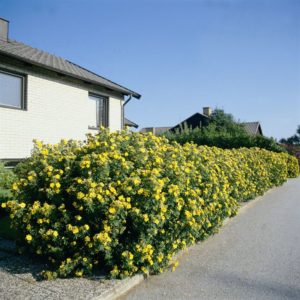
- Goldstar.
From yellow-flowered plants stands out silverweed shrub Goldstar. A small shrub with a height of 0.6-0.7 m in June is covered with large golden-yellow flowers (up to 5 cm in diameter). Abundant flowering continues until the first frost.
- Abbotswood.
The silverweed shrub Abbotsvud belongs to the group of white-flowered species. This is a low shrub up to 1-1.2 m in height. The size of white flowers is small and is 2.0-2.5 cm in diameter, but a large number of simultaneously opened petals and long flowering from June to September suggest that this variety is the best of the group.
- Red Ice.
From the representatives of the third group, the Red Elderberry spice stands out. The plant blooms for almost three months, while during the whole season the petals change color: at the beginning of summer, orange-red flowers bloom, in the middle of the season they turn yellow-orange, and with cooling periods they become saturated red. Shrub compared to the above varieties is not so high - the length of the stems is 0.6-0.7 m, and the diameter of the crown grows to 1.2 m.
- Lovely Pink.
We can not ignore another variety - silverweed Shrub Lovely Pink (Pink Beauty), bred by UK breeders. The plant justifies its belonging to the Rosaceae family - its large bright pink flowers up to 5 cm in diameter abundantly cover a relatively low (0.5–0.6 m) bush. Despite the high decorative effect, Lovely Pink tolerates the conditions of the metropolis, drought and frost. These qualities make it indispensable for decorating the cityscape as a tapeworm or hedge. Gardeners planted shrubs in ridges, rock gardens, in combination with perennials, and even used as a ground cover plant.
- Princesses.
The silverweed Princess in adulthood reaches 0.6-0.8 m. The shrub is covered with light pink flowers with a yellow center, not typical of other plant species. The diameter of the flowers does not exceed 3 cm. Flowering continues from May to November, depending on the climatic conditions of the growing area.
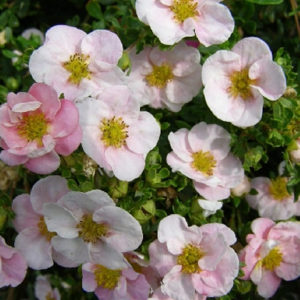
- Mango-tango.
From the variety of species, cinquefoil shrub Mango-tango is distinguished - a low shrub (0.5-0.6 m) with spectacular large flowers of mango color. In cool weather, red-orange flowers become saturated red.
A wonderful decoration of the garden is the silverweed hybrid, bred by breeders by crossing different species. Its large double flowers can be of various shades: yellow, pink, red and purple.
Unpretentious and at the same time decorative garden shrub pasty, planting and caring for which does not cause any problems, regardless of the variety. With this she deserved love from flowering plants lovers and landscape designers.
The plant grows equally well on any, even infertile, soils. But the best result can be achieved by growing Kuril tea on loose nutrient soils with good drainage and pH value of pH 7.0-8.5.

In the wild, a five-leaf plant grows in large open spaces well lit by the sun. In garden culture, it is better suited to the bright corners of the garden, where the sun's rays will delight at least 6 hours during the day. Constant sun is undesirable for a plant - in bright light, the color of the flowers becomes pale.
The cinquefoil shrub, the planting of which is possible both in the autumn, and in the spring, and in the summer, has a superficial root system, therefore it does not need a deep planting pit. According to gardeners, it is still worth planting a shrub in early spring, as soon as the snow melts and thaws the soil:
- A pit is prepared wider and deeper twice than a store container or an earthen clod (depending on how the roots of the plant are “packed”).
- When landing as a hedge between the bushes leave a distance of not less than 0.6-0.7 m.
- At the bottom of the landing pit must lay a layer of lime gravel, which will perform the function of drainage. As a drainage layer also use river pebbles or broken bricks.
- Prepare a soil mixture of leaf earth, humus and sand in a ratio of 2: 2: 1.
- The pit is filled with half prepared mixture. 100-150 g of complex mineral fertilizer are added to it, mixing the granules well with the ground.
- Sapling is not deepened - the root of the neck should be slightly above ground level.
- Then the pit is filled with the remaining earth, but without adding fertilizer, it is well tamped and watered. After watering, the ground will settle and the root collar will be flush with the surface of the plot, which is optimal for good growth of the silverweed.
- For the first three weeks, the cinquefoil is watered as the top layer of the earth dries.
So that the soil does not dry out too quickly, it is mulched with straw, wood chips or sawdust with a layer of 5-7 cm. In the future, rooted and adult plants will not have to be watered too often.
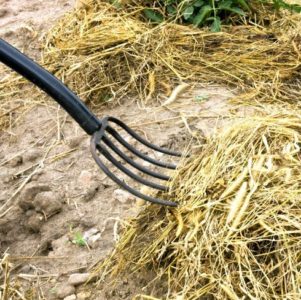
Care rules
Caring for cinquefoil shrubs includes watering, loosening, feeding and pruning.
Kuril tea tolerates dry air and a long absence of watering, but it is better not to allow the earth to dry out. During the summer season it is watered additionally 3-4 times, pouring 1.5-2 buckets under each plant, and if the summer is dry, then the number of irrigations increases. The quatrefoil responds well to sprinkling, which is carried out in the evening after sunset.

Loosen the soil to a shallow depth of 5-10 cm, not forgetting the superficial roots that are easily damaged. Loosening and weeding help to saturate the roots of the plant with oxygen and free the area from weeds.
Potentilla shrub, varieties of which differ in variety of colors, is able to decorate flowerbeds and gardens for 20-30 years. And although most bushes have a natural rounded shape, each year it must be maintained with the help of formative pruning.
Pruned shrubs are pruned in late autumn and early spring. If you hold a "haircut" in the fall, then in the spring Kuril tea does not take precious time, which is so lacking in this "hot" time for gardeners. However, it is better for the residents of the middle lane and northern regions to allocate an hour of free time for spring pruning, so that the quatrefoil overwinter with the old branches - they will help to keep the snow and transfer the frosts without loss.
For pruning, you will need a fan-shaped rake and a good secateur that can “have a snack” and not flatten the branches of the shrub, which with age reach a diameter of 1-1.2 cm:
- A fan rake clears the soil around the bush, freeing it from old leaves and grass.
- Secateurs cut the branches of a five-leafed sheet, trying to give the crown a symmetrical shape resembling a ball.
- When pruning, branches are shortened by about a third the length, maximum - by half, not more.
- Dried and damaged branches cut out completely.
- Sections are treated with garden barb.
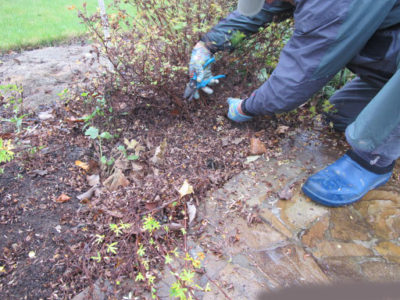
Forming pruning not only improves the appearance of the shrub, but also stimulates its abundant flowering. During the summer, the shrub bush will transform into a thick green ball, thickly covered with flowers. Since Kuril tea belongs to slow-growing plants, gardeners recommend “cutting” a bush every 2-3 years.
Tip:Considering thatplantbloodroot - “long-liver”, gardeners recommend every 5-6 years to carry out a radical rejuvenating haircut, after which hemp is left 15-20 cm above ground level. Young twigs will grow quite quickly, and the plant will once again take on a decorative appearance.but for this after trimminglapchatka be sure to feed.
The quatrefoil is fertilized annually in the spring after the appearance of the first green leaves. Phosphate fertilizer and potassium sulphate are used as top-dressings, which are diluted at the rate of 25-30 g per 10 l of water. Knowing how to feed a plant, it is easy to achieve lush and long flowering.
Potentilla shrubby, care for which is not complicated, is highly resistant to insect pests and fungal diseases. When signs of rust or powdery mildew appear, the plant is treated with colloidal sulfur, Bordeaux mixture or ready-made fungicide preparations.
It is not necessary to cover Kuril tea for the time of cold weather - a good winter hardiness of the plant facilitates the work of gardeners during the preparatory work for the winter.
Herb species
- 1 Silverweed Nepalese.
The above varieties are perennial shrubs. You can not ignore the grassy varieties. Of particular interest is the Mordotus Nepalese Miss Wilmont. This perennial with straight branched stems, reaching a height of 0.5 m, and fairly large pink-red flowers with a diameter of 2.5-3.0 cm, collected in paniculate inflorescences.
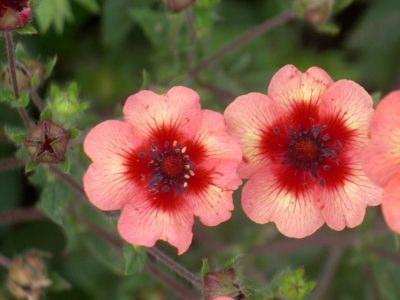
In recent years, gardeners Nepalese have been popular with gardeners, and even inexperienced growers can grow and care for it.
Growing from the seeds of the Pepodka Nepalese under the force of even an inexperienced gardener. Seeds laid out over the ground and sprinkled with a small layer of earth. After 2-3 weeks, shoots appear, and after 2-3 weeks, the sprouts dive and plant in a permanent place in the garden. For successful germination of seeds and growing seedlings, the air temperature should not fall below + 18 ° C.
Potentilla Nepalese needs the same lighting and soil composition as the shrub varieties, and timely feeding will ensure good growth and abundant flowering. However, we must remember that when planting seeds the plant will bloom only in the second year.
Potentilla Nepalese reproduces and division of rhizomes - a simple and productive way. To do this, dig up the mother bush in spring or autumn and cut it into several pieces with a sharp disinfected shears. Delenki planted in a permanent place in the garden, reserved for future bushes. When planting in a row between bushes, a distance of not less than 0.3 m is left so that the overgrown Lapchatka Nepalese does not drown out the neighboring bushes.
Potentilla Nepalese does not require special care - it applies all the same agrotechnical conditions as for the shrub varieties.
- 2 Silverweed is white.
In contrast to its “relatives”, silverweed white grows only 8–25 cm in height. This perennial herb is used in traditional medicine and the pharmaceutical industry. Rhizomes harvested from autumn are useful from a therapeutic point of view. Leaves and stems do not have healing properties and do not represent values for herbalists.
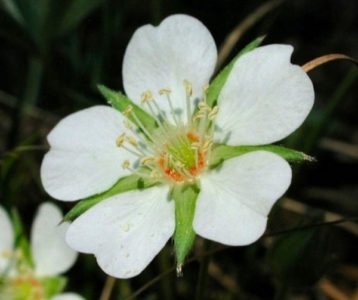
The rhizomes of the five-leaf leaf contains trace elements: silicon, aluminum, manganese, zinc, and iodine. The iodine content gives a special value to the plant - many medicinal products intended for the treatment of diseases of the thyroid gland include extracts and extracts of cinquefoil white.
Potentilla white grass grows in Europe, occupying territory from the Volga to Central Europe, it can be found in Ukraine, Bulgaria, Italy and Yugoslavia. If the silverweed Nepalese prefers light areas, then the white loves half-shaded places and is found on forest edges, in coppices and meadows. It is used by gardeners as weed suppressing the growth of weeds. This type of pendent leaf is grown even as an ampelous plant, planted in hanging pots.
Important:Due to the intensive development of forest and rural farms plant cansee less and less - in many countries where earliersilverweed grassy was found everywhere; it is on the conservation lists of endangered species.
Application in landscape design
Without exception, all types and varieties of Potentilla are highly decorative. At any site will look equally spectacular as shrub varieties, and grassy.
Thanks to the forming pruning, the shrub five-leafed clover will become a spectacular soliter, which will attract the eye, the hedge or group planting will also look beautiful.
Low-growing varieties of perennial are planted in flower beds, rockeries and rocky gardens, and grassy - in flower beds in combination with other perennials. So, yellow silverweed looks cute with blue and blue flowers, silverweed red - with white and pink.
The “neighbors” of Kuril tea are absolutely worthy of any plants other than pine, which, like the five-leaf leaf, may be affected by rust.
An unpretentious and at the same time attractive potentilla is able to decorate a city park, flower bed or lawn, and in the garden plot there is a corner for this unpretentious plant. Even a novice grower can grow a wonderful shrub that will bloom throughout the summer season.
And a little about the secrets ...
Have you ever experienced unbearable joint pain? And you know firsthand what it is:
- the inability to move easily and comfortably;
- discomfort when climbing and descending stairs;
- unpleasant crunch, clicking not at own will;
- pain during or after exercise;
- inflammation of the joints and swelling;
- unreasonable and sometimes unbearable aching pain in the joints ...
And now answer the question: does it suit you? Is it possible to endure such pain? And how much money have you already “leaked” to ineffective treatment? That's right - it's time to stop this! Do you agree? That is why we decided to publish an exclusivean interview with Professor Dikul in which he revealed the secrets of getting rid of joint pain, arthritis and arthrosis.
Among the perennials living in the flower bed, there are striking specimens that have not only luxurious appearance, but also useful properties. Against the background of their relatives, cinquefoil shrub care stands out favorably and the cultivation of which is characterized by simplicity. Its main advantage is good frost resistance, but it also has other secrets, which you will learn from the materials of the article. The article will tell in detail about the reproduction of the shrub, growing conditions, interesting
cultivars, useful properties, recommendations for combination with other garden dwellers.
Potentilla shrubby: description, photo
Potentilla shrub has been a subject of debate for a long time. Botanists could not decide which genus to include perennial from the largest family of Pink. Previously, it was included in the homonymous genus Potentilla. The name comes from the shape of the leaves, resembling a small foot.
Later, the genus became known as Kuril tea, because most species grow in Asia and have long been used to brew a healing drink. The Latin name is formed from two words, translated as "bearing dense pubescence." Foliage densely pubescent with short hairs. Now the plants belong to a separate genus Pyatilistik or Pentaphylloid (Pentaphylloides) again because of the shape of the leaf cover.
It is interesting! Representatives of the genus are so tenacious that they can grow in permafrost conditions.
The distribution of the quatrefoil is extensive: it covers Asia, Europe, North America, Siberia, Transbaikalia, and the Caucasus. Most of the representatives prefer to grow in mountainous terrain, tundra, forest, meadows, near rivers and streams. They love moderately moist soils with good drainage, but can also grow on dry, depleted soil, where they quickly lose their decorative effect.
The wild varieties of the five-shrub have a bush habit. The length of their upright shoots varies in the range of 0.1-1.5 m. Graceful twigs branch strongly, covered with brown, grayish or red-brown bark, prone to peeling. Young growth densely pubescent with fine hairs, adult branches are bare. Shrub is a deciduous species. Carved foliage gives perennial high decorative qualities. The plate consists of 2-3 pairs of leaves with triad vertex.
The shape of the leaves is oval or oblong-ovate. Length up to 30 mm, and the width of each leaflet does not exceed 10 mm. The surface of the plate on both sides is covered with adhered short hairs.
Bushes are covered with large (up to 35 mm) flowers at the beginning of summer and remain decorative until the end of the season. Numerous flowers appear singly on the shoots or gather in apical umbellate, scabrous, racemose inflorescences of 2-7 buds. Petals are ovoid, the main color of wild species is yellow. Only shades of halos are variable. Decorative varieties are characterized by an abundance of shades of corolla, growth and shape of the bush. The middle of the flower seems fluffy due to the abundance of stamens.
Each flower lives for 6-48 hours, after which it fades and begins to form a brownish hairy achene.
Know The duration of the flowering of Kuril tea with proper care exceeds 2 months. Unkempt bushes quickly run wild, losing decorative.
The quatrefoil is valued by gardeners not only for the opportunity to make delicious tea. Long abundant flowering, excellent decorative qualities, unpretentiousness, resistance to dust and frost resistance are undoubted advantages of perennial.
Types and varieties of Potentilla shrub
The genus Five Mustard includes only 10 species of shrubs. On the basis of botanical varieties with yellow corollas, a mass of cultivars with red, pink, cream, orange and white colors is derived.
The main types of Kuril tea found in culture:
- dahuri;
- shrub;
- dryaceous;
- Fridrikhseva;
- small-leaved;
- manchurian.
The Daur pyatidistochnik has been cultivated in gardens since 1822. Distributed in the north-east of Korea and China, in Siberia, Primorye. The name of the species was due to a large concentration in the territory of Transbaikalia, called Dauria. It prefers to grow on rocky limestone soils, scree, near rivers and on wet meadows. Refers to calcephils, i.e., preferring soils rich in limestone.
The shrub reaches 0.5-0.6 m, has bare dense branchy shoots. Leaflets are typical for members of the genus Pentaphylloides - small, oblong, gathered in the "foot" with a pointed middle. The surface of the plate is dense, leathery, glossy.
The upper part of the sheet is painted green, and the bottom is gray. Dahurian species bloom in early summer and pleases the eye before the end of the season. At the ends of the shoots are single, white flowers with a diameter of 20-25 mm are arranged in pairs or small umbrellas. In some cultural forms, the scope of the petals reaches 5 cm, but in Russia they prefer to grow a botanical form.
During flowering, complex seeds begin to mature, ripening by September. If you propagate this type of cuttings, the flowering will begin 2 years after rooting.
Know Botanists estimate the winter hardiness of Dahurian Kuril tea as full. Only in the most severe winters, the ends of annual shoots slightly freeze slightly.
Winter hardiness is caused by full lignification of the shoots to the beginning of winter. So, cover the fluffy bushes for the winter is not necessary.
The shrub five-leaf plant grows under the same conditions as the Dahurian, but its range covers more areas - forests and steppes of Europe, all over Russia, Central Asia and the Caucasus. Prefers pebble, rocky cracks. Loves moisture, forms extensive thickets. Cultivated throughout Russia, it can grow both in the Arctic Circle and in the southern regions.
The length of the shoots is 1.5 m. The shoots are strongly branched, covered with brown, reddish or gray peeling bark. The crown has a hemispherical shape, is easy to adjust and retains compact dimensions for a long time. Foliage is lanceolate-oval, pinnately complex. Each leaf consists of 3-7 blades up to 30 mm long. The edges of the plates are stupidly pointed, curled, the surface is covered on both sides with thick fuzz.
The flower corolla consists of 5 oval petals with a golden yellow color. The diameter of the bud reaches 2 cm. The flowers appear singly in the leaf axils along the entire length of the shoot or are collected in small apical shields. The period of decoration from early summer to October. Ripe fruit seeds resemble tiny shaggy buttons. Winter hardiness is high. Perennial picky about the composition of the soil, prefers rich in organic soil.
It is interesting! Depending on the climatic conditions in which the bushes used in the hybridization grew, their winter hardiness changes. If a hybrid is of European origin, then its winter hardiness in the conditions of Russia should be subjected to tests.
Americans and Europeans prefer to grow cultivars with different color of petals, rather than a wild-growing species with golden flowers.
Varieties are divided into tall and stunted, with different colors of leaves and corolla. In the climatic conditions of Russia, not every cultivar will feel great. Currently there are over 130 hybrids of the shrub variety. Among them, the love of gardeners won the following varieties:
- Abbotswood. Low shrubs up to 1 m have a dense crown with light green foliage. The diameter of the “cushion” is up to 1.3 m. Snow-white buds with a diameter of up to 25 mm open by the beginning of summer and delight the eye before the end of the season. The best curb grade.
- Guilford Cream. Low-growing hybrid 0.4-0.6 m with an extensive crown, reaching a diameter of 1.2 m. The bush is thickly plastered with bright green carved leaves. It blooms from late spring to September with large cream-colored buds.
- Goldfinger. The length of the branches is 1.2-1.5 m. The crown is dense, forming a dense dark green cushion of the same diameter. Bright yellow beaters reach a size of 5 cm. One of the most attractive beautiful flowering hybrids.
- Veitchi. Forms spherical bushes with a height and girth of a crown of about 1.5 m. It is distinguished by luxurious white petals surrounding a fluffy core with red anthers.
- Golden Star. The growth of shrubs 0.8-1.0 m, the crown in girth a little over a meter. The foliage is grayish-green. Buds pale yellow, large - up to 5 cm in diameter. The cultivar has a later and short flowering from mid-summer to September, which is compensated by abundance.
- Kobold The most undersized variety, reaching a height of 0.5-0.6 m. Crohn forms a lush thick pillow of light green color with a diameter of 1-1.2 m. Light yellow corollas swing open by mid-summer, decorativeness is 3-4 months. Due to the rapid pace of development requires special attention to pruning. Ideal for forming a hedge.
- Golden Dwarf. Growth is 0,6-0,7 m. Graceful branches strongly branch, forming a magnificent light green growth. Young growths are pinkish red. The branches are covered with a large number of golden-yellow flowers with a size of 20-30 mm.
- The pink queen. Height 0.8 m, girth up to 1.5 m. Petals are pink, the diameter of the corolla is up to 4 cm. It is decorative during the summer.
- Goldteppeeh. Hardy hybrid, frost-resistant and resistant to fungi. Appreciated for the abundant and long bloom large golden-yellow buds. Shoots creep, reach a length of just over half a meter. Dense pillow formed from gray-green foliage.
- Pretty Polly. Bush up to 0.6 m tall forms a very dense wide (1.2 m) crown of a dark green shade. The petals on the edge of a little lighter to the middle become dark pink. The rim is 3.5 cm across.
- Jackman The silver leaves of a tall hybrid form a sprawling crown with a diameter of up to 1.5 m. Light yellow petals burst open in May, small flowers please the eye until the end of summer.
- Princess. Dense dark green pads of this hybrid in girth up to 1.2 m. Plant growth 0.7-0.8 m. The shoots are thickly covered with pink flowers with a diameter of 30-35 mm. Prized for early, long flowering, starting in late spring.
- Klondike. The foliage of this meter-long shrub forms a spreading crown, the color of which is gradually darker by mid-summer. Large corollas swing open in May, have a light yellow shade. Widely used in ornamental gardening.
- Red ice The light-green cushion reaches 0.65 m, in girth up to 1.2 m, consists of gentle creeping branches. By the beginning of June, orange-red petals are revealed, changing the shade to orange-yellow. Decorative all summer.
- Royal Flush. Low hybrid of American selection. It blooms with red buds that change color to dark pink. In the fall, dark green foliage casts silver.
- Farreri. The undersized hybrid changes a shade of krone from light green for silvery. It has medium-sized flowers (3 cm), dark yellow color.
- Red Robin. Pleases gardeners with bright red petals throughout the summer. The length of the shoots is 0.6 m, the span of 1.3 m.
- Snowbird A large number of whitish-cream flowers 4 cm in size are revealed on a light-green pillow with a length of 0.7 m.
- Elizabeth. Among the relatives, the cultivar is distinguished by the decorative openwork foliage of a bluish-green color. Corollas 40 mm, open to the beginning of summer, bloom until October. Petals are painted in light yellow tones.
Know Despite the abundance of varieties, Russians prefer to cultivate traditional Kuril tea.
Dry-flowered quatrefoil is found in the Altai and Central Asia, near the "roof of the world" - the Pamirs. It grows in rocky places, growth does not exceed 12 cm. Creeping shoots rise, pubescent, have a reddish tint. Very small leaves curled around the edges. The flowers are small with a purple cup and white petals. Not found in ornamental gardening.
Fridrihseva's five-leaflet got its name from the name of the botany who described the species. Since the “parents” of this form have become the shrub and Dahurian varieties outwardly, it practically does not differ from them. The foliage is bright green, small, pubescent. Flowers are over 30 mm in diameter with pale yellow or cream colored petals. The high degree of winter hardiness and the possibility of seed reproduction make this species promising for mass landscaping of parks. Growth and girth of the bush 1-1.2 m.
Small-leaved species is common in Siberia, Mongolia and Central Asia. Due to its low height (20 cm) it is widely used to decorate alpine slides, rockeries. The leaves are small, the plate is formed from 7-9 pieces. The color of the upper part is gray-green, from the bottom the leaf appears silvery from a large number of hairs. It has numerous yellow flowers with a diameter of up to 15 mm.
Important! Of all the species included in the genus Pentaphylloides, for breeders and gardeners only shrub is important. Botanists believe that other forms have been undeservedly overlooked.
The Manchurian Pentatecover is common in Primorye and northeastern China. It grows on the slopes of mountains, scree. Height about half a meter, girth of silver-white pillows 0.8 m. In culture is very rare. Young shoots require special attention of gardeners, since the threshold of winter hardiness is very low, adult specimens are hardy. The combination of decorativeness, frost resistance and unpretentiousness makes the Manchurian five-leafed grassland promising for gardening and park greening.
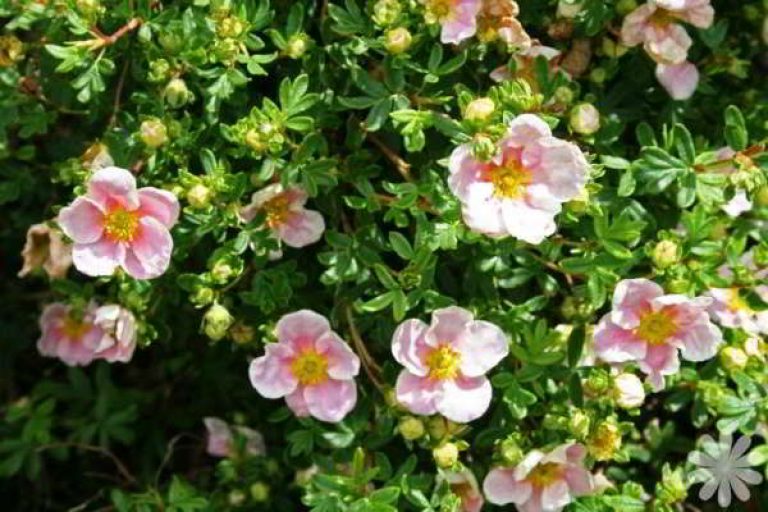

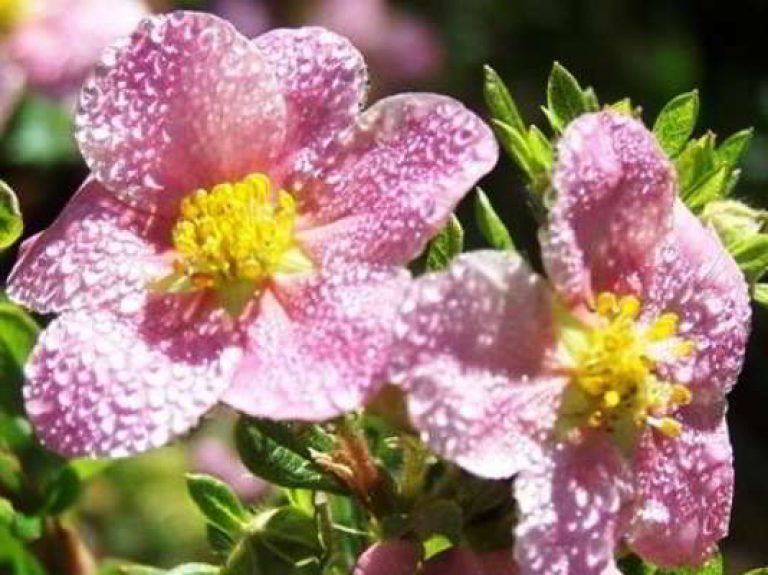
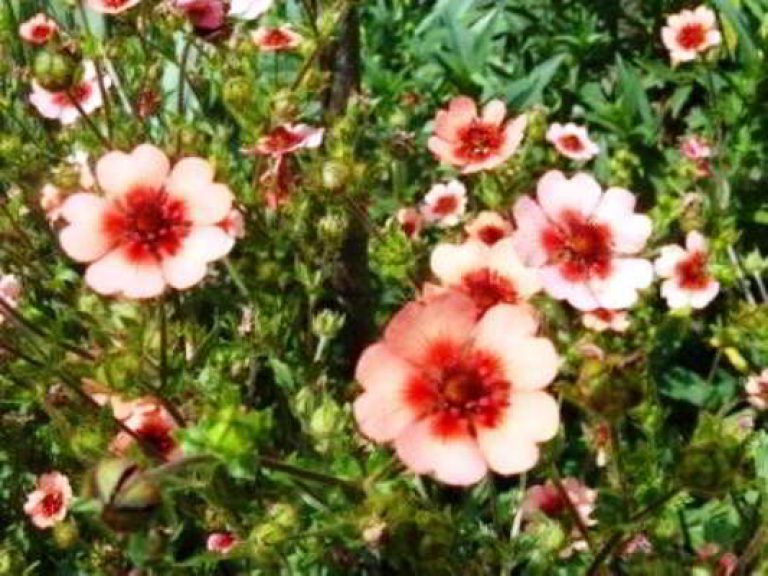
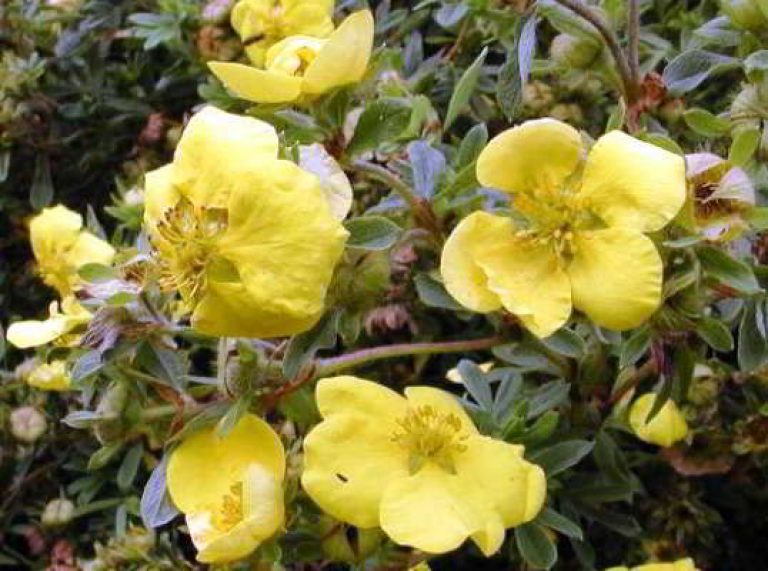
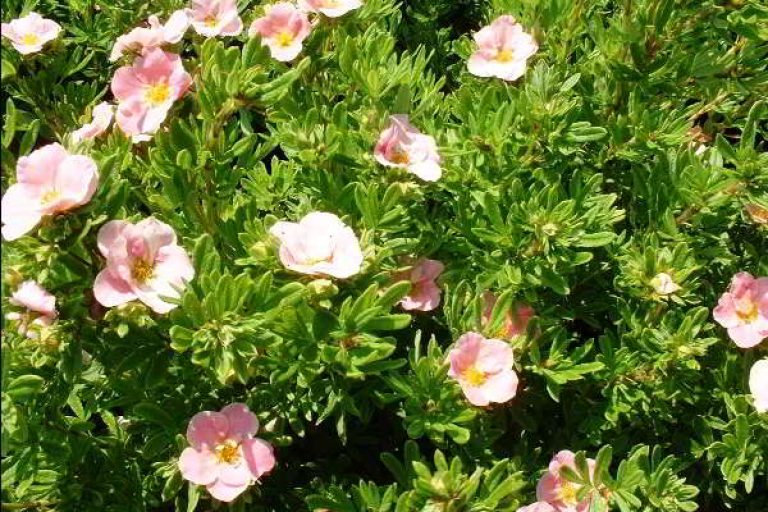
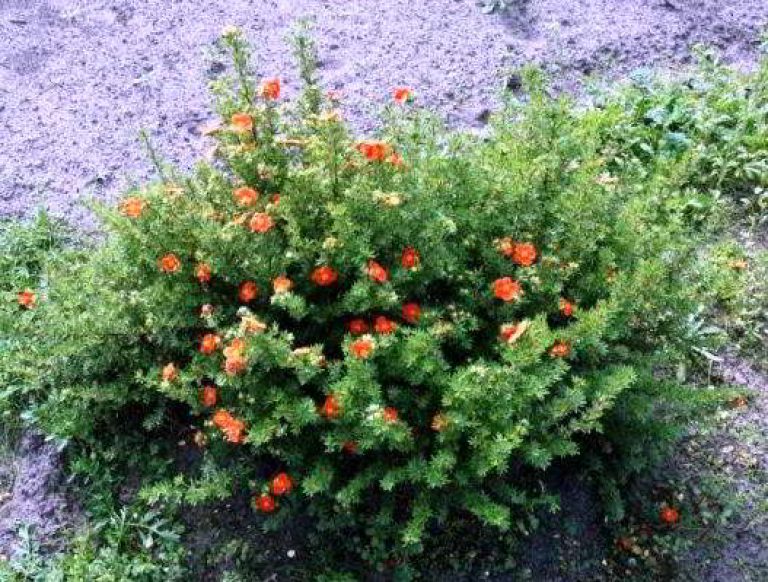
Planting Potentilla
To enjoy the bright flowering of the five-leaf plant, it is necessary to plant it according to all the rules.
Choosing a landing site
The enduring Kuril tea feels great in the open space. Even the raging cold winds this holarctic perennial does not scare. As for lighting, the shrub will be more comfortable in light shading. Direct sunshine for him are not dangerous, but the petals under the influence of the sun burn out much faster, this shortens the total decorative period. In full shade, the growth weakens, lags behind in development and practically does not bloom.
Preparing the soil for planting
Kuril tea is demanding on soil structure. It grows poorly on too dense or clay soil. Due to the occurrence of groundwater, the delicate roots are damaged, so drainage is required when making the landing pit. The optimal composition of the substrate consists of two parts of leafy ground, the same amount of humus and one part of large river sand.
Know Since the quatrefoil is a Calcephilum, it calmly tolerates a high content of carbonates in the soil. Acidity for normal development should lie in the range of 5.5–7.5, i.e., from weakly acid to weakly alkaline.
Landing pit characteristics
When preparing the landing pit, it is necessary to take into account a number of requirements. The hole must be dug in advance at least 2 weeks before the planned work. This is done to ensure that the soil has time to thicken, and during transplantation no air voids were formed.
The parameters of the hole should be such that the transplanted bush fully fit there. It should be borne in mind that the laying of a drainage layer with a height of 15-20 cm is obligatory. Usually 50-60 cm deep wells and a diameter of half a meter are enough, because the root system in Kuril tea is superficial. After the soil has been removed from the hole, take the fertile (top) layer and set it aside. When a footprint is formed, a nutrient substrate is laid in the lower part, and the upper layer will consist of the removed fertile layer.
Planting shrub Potenka in spring
Planting Algorithm:
- spring planting takes place in the early stages, immediately after the snow cover and partial melting of the ground;
- place a drainage layer of brick chips or pebbles, crushed stone on the bottom of the prepared pit;
- in the acquired seedling, shorten the central roots, forming a branched root lobe with a network of small roots;
- pour nutrient substrate on top of the drain, add 150 g of complete mineral fertilizer to it;
- place fertile soil on top of the nutritional pad and compact thoroughly. The whole mass should take up about half a well;
- place the root system in the hole, spread the roots and gently sprinkle with fertile soil. If you plant a cinquefoil on untreated soil, be sure to fertilize the top layer by mixing it with organic matter (compost, humus);
- make sure the root neck is at ground level;
- compact the substrate, pour at the rate of 1 bucket under each bush, mulch with peat chips.
On a note! The distance between the specimens is recommended to leave about 1 m, but it is significantly reduced (up to 40 cm) when forming a hedge.
If you plan to plant bushes to trim the curb, use an alternative method of planting. It consists in preparing not individual holes, but long trenches. The requirements for them are the same as for the pits. This method is preferable for Kuril tea, because in nature it is accustomed to grow in large thickets.

Nuances of planting silverweed in autumn
Autumn planting is similar to spring, but differs in timing. It is important not to miss the moment and plant the seedlings at a permanent place by mid-September. This is due to the peculiarities of the root system. The network of side roots, necessary for good rooting, develops only under the condition of warm weather. If you delay the planting time, the bush may not have time to start and will not tolerate the first wintering.
Silverweed shrub care
Kuril tea is by nature very enduring, so the cultivation of this beautiful and healing plant does not take much strength from the gardener.
Watering
Due to the habitat of natural species in difficult conditions, they adapted for a long time to do without moisture. When watering, special attention should be paid to young saplings. The first 2-3 weeks irrigate them weekly, and then be sure to loosen the soil to a depth of 5-7 cm and remove weeds.
Important! Mulching will help to avoid the rapid evaporation of life-giving moisture, so do not neglect this procedure.
If adult bushes are undemanding for irrigation, then air humidity plays a big role. Water mature specimens only in dry weather using a bucket of water for each bush. Be sure to spray the green ward in the evenings, this procedure will have a beneficial effect on the state of the leaf cover. Lack of the sun will not allow to damage gentle petals and will save foliage from burns.
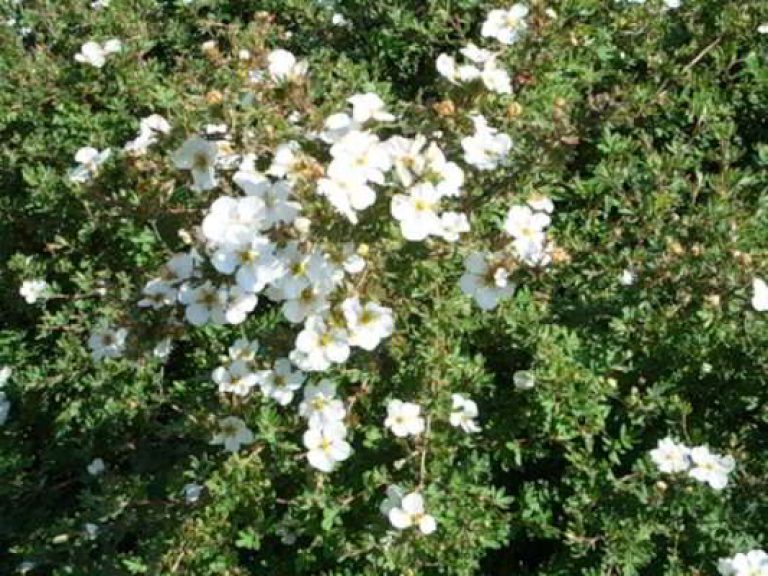
Top dressing
If you have laid the recommended top dressing in the planting pit, then the next stage of fertilization will be in the spring. To ensure long-term decorative shrub potash-phosphorus complex is needed. Add mineral salts at the rate of 120-150 g per square meter.
Pruning
The compact dimensions of most cultivars require formative pruning only once every 3-4 years. Crown formation is carried out at the beginning of the growing season, combining it with rehabilitation, or in early autumn. In the first case, remove all dried, damaged and diseased branches, and the rest of the shoots are pruned by 7-10 cm. When autumn is formed, it is done by shortening each branch by a third.
Know With proper care, green pillows remain compact for 3 years.
Planting shrub sponge seeds in open ground
It is possible to grow a cinquefoil by sowing seeds in open ground. Collect the seed material is not difficult. The collected seeds remain viable for up to 4 years when stored in a cool, dry place.
When to sow seeds
Seeds before sowing must be stratified for 3 months. At the same time, they will germinate faster, but germination is good without stratification. In the first case it is necessary to plant closer to the end of spring, and in the second - in early spring.
Preparatory work in the ground
Usually sowing works are carried out in heated greenhouses or on a windowsill. Sowing is carried out in rasadny boxes. The substrate must be nutritious, loose, moisture-intensive. These requirements are met by a mixture of leafy ground with sand in a 2: 1 ratio. Be sure to sift the soil mixture.

When sowing directly into open ground, it is better to use stratified material. Prepare the bed in the penumbra, replacing the top layer on the leaf ground.
Sowing seeds
Seeds are sown in boxes filled with the substrate or on the garden, in the greenhouse, pre-watered soil. Spread the seed evenly over the surface. Sealing up the seeds is not necessary, just lightly sprinkle.
Reproduction Methods of Potentilla
Kuril tea breeds both in seed and vegetative ways - cuttings, dividing the bush, root suckers.
Seeds
We have already figured out how to sow the seeds, now let's talk about the care of seedlings. It must be said that the shoots from the five-leaf plant are very small. Therefore, they need to be watered carefully, the same applies to the application of top dressing. It is better to use a spray for irrigation or irrigate by immersion. Top dressing is brought with use of the syringe.
Attention! When seed reproduction varietal characteristics are not preserved, most often the seedlings return to their original form.
When sowing in early spring, young shoots are planted in separate tanks of greater depth. Picks carried out by the end of spring, pre-hardened seedlings. Take out the boxes in the garden, constantly making sure that the seedlings do not get sunburn. When the active growth of seedlings begins, apply a top-dressing consisting of a complete mineral complex or mullein solution, diluted 1:20.
During the year, seedlings will grow by 3-5 cm, in the second year of growing season their growth will be 12-15 cm. Only by 3-4 years old seedlings will look like adult specimens and they will be planted in a permanent place. Seedlings bloom in 3-4 years.
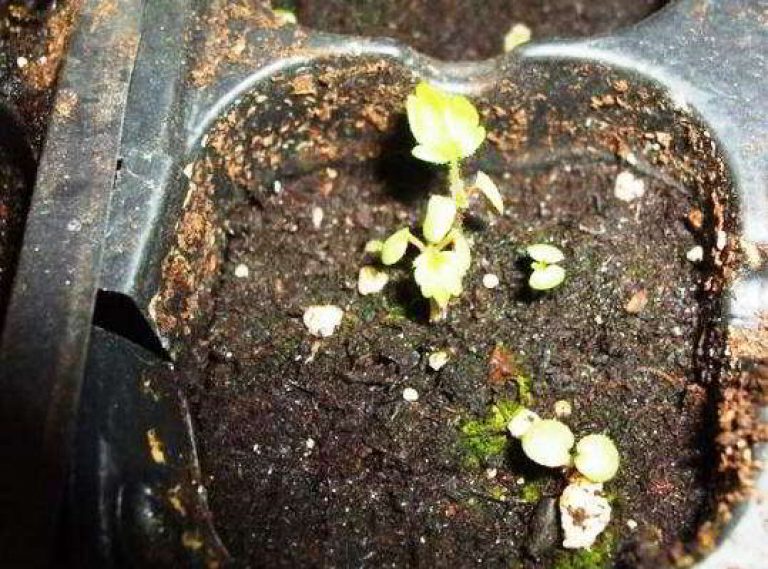
Since this method does not preserve parental signs, it differs in duration, it is rarely used at home. Industrial cultivation by the seed method allows you to get a lot of young individuals at once.
Layering
To get the layers, choose the extreme developed shoots. Press the base with soft wire and pin them in a shallow groove. Fertile soil is poured from above, treated in the same way as the mother liquor. By the end of the season, a root lobe forms on the branches and they are divided and seated. It is better to leave this event until the next spring, then the seedlings are planted in a permanent place.
Tip! To accelerate the formation of roots will help simple proven method. Apply shallow wounds to the bark on the underside of the twigs and roots will appear in this place.
Radical shoots formed by the bush are separated and planted in a permanent place. Rhizomes offspring are produced in a small amount, but can significantly reduce the time of development. Layering bloom in the next season.
Dividing the bush
Overgrown bushes aged 4-6 years are divided into several parts, while receiving from 2 to 6 new copies. The procedure is best done in the spring. Remove the bush and pruning shears. Each part landed on a permanent place. If during division you have left a well-developed root lobe and the number of buds, the young growth will bloom this year.
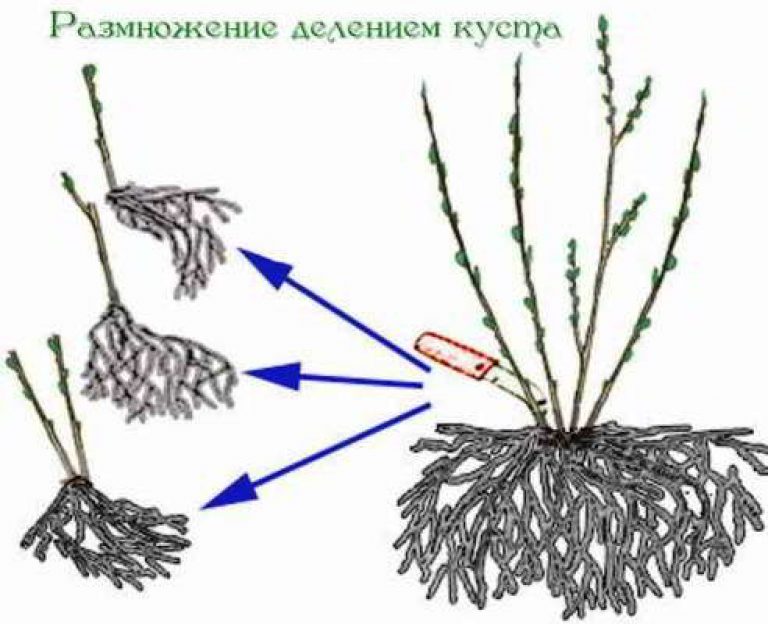
Cuttings
Eavesdropping is an affordable and simple perennial breeding method.

Main steps:
- When using green cuttings, the material is cut early in the morning or in cloudy weather, when the greatest amount of vegetable juice is concentrated in it. Cutting length 8-12 cm.
- Remove the lower leaves completely, the upper half, remove the top with flowers, so that all the forces of the germ are thrown on the rooting.
- Put the sliced material in a container with heteroauxin for a day, the temperature is not higher than 25⁰C.
- For rooting, use a substrate based on a mixture of peat and sand or perlite. Place a layer of substrate 10 cm above the leafy ground and plant the cuttings to a depth of 3-5 cm in increments of up to 10 cm.
- Rooting spend under a transparent cover with the organization of frequent spraying (constant humidity) and a temperature of 22-28⁰C. Rooted seedlings in greenhouses or nurseries, and on the ridges under the film, subject to the creation of shading.
- After rooting, apply top-dressing with a complete mineral complex. The next year, plant seedlings in a permanent place.
- In order for the layers to successfully winterize, they must be covered with a layer of mulch 15-20 cm from peat.
- Lignified cuttings are cut in early spring, before budding. Length 10 cm.
- The rooting conditions are the same, but they deepen the cutting so that a tail 2 cm long remains on the surface.
Know Cutting allows you to get a large number of new individuals, fully preserve the parental signs and reduce the period of cultivation to 2 years. Therefore, gardeners often resort precisely to this method of reproduction.
Potentilla after flowering: autumn, winter
With the onset of autumn, perennials stop watering so that the wood is fully ripe. If necessary, carry out pruning. Good winter hardiness allows the bushes to winter without shelter, but young shoots need it. Peel foliage from the root space and build a fifteen centimeter layer of peat.
When purchasing a sapling, be sure to consider zonality, because most of the hybrids are based on heat-loving species. Remember the simple rule - good winter hardiness in varieties with white and yellow flowers, lower in red, orange, pink cultivars. They will need shelter for the winter.
Diseases and pests of Potentilla bush, treatment
Pyatistochnik by nature received strong immunity. Pests bypass it, and diseases arise only through the fault of the gardener. Diseases caused by fungi attack the foliage in violation of agrotechnology - thickening of plantings, stagnation of moisture in the root zone, excessive moisture, sharp fluctuations in the temperature background.
Usually spots appear on the foliage of various shapes and colors. With powdery mildew whitish, with rust brown with purple bloom from the bottom of the sheet, and with spotting, the color can be from black to yellow. Having noticed traces of the activity of the fungus, it is necessary to remove the strongly affected parts and carry out the treatment with fungicides - Topaz, Fitoverm, Fitosporin, Fufanon.
Tip! To avoid rust, plant a bush away from the pine. The fungus develops on the bark of the tree and, under favorable conditions, disperses the spores.
Potentilla shrubby in landscape design, combination with other plants
The quatrefoil perfectly acts as a soloist, forming bright cushions, and in group plantings in the neighborhood with more tall garden dwellers. Looks great along the curb, as a hedge or slope decoration. Low-growing species are appropriate to decorate rockeries, stony gardens, alpine slides.
Shows the best decorative qualities in the neighborhood with thuja, yew and juniper, host, geykher. Delphinium, snapdragon, lavender, hyssop will be excellent neighbors for her.
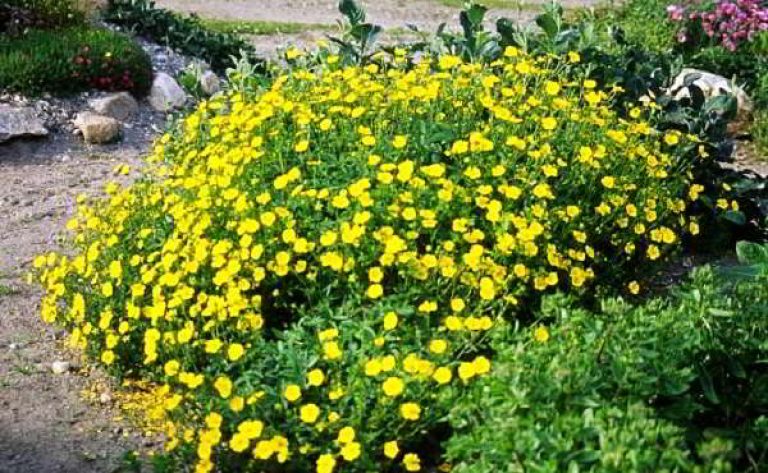
Useful properties of shrubby sponge and contraindications
What is useful Kuril tea, how to brew it and what contraindications has a healing drink, you will learn from this section of the article.
As a medicinal raw materials from the shrub collect shoots, leaves, flowers. From the usual tea herbal drink differs in aroma and composition, it resembles black tea in taste. The composition of the raw material includes a large amount of ascorbic acid - the concentration of vitamin C is more than 5 times in lemons!
In addition, the raw materials contain antioxidants, trace elements, carotenoids, essential oils, flavonoids, resins. This composition gives the drink anti-inflammatory, antimicrobial, diuretic, tonic, rejuvenating, anti-cancer, analgesic properties.
Attention! Allergy sufferers should closely monitor the response of the body.
Make Kuril tea 2 tablespoons of raw materials per 300 ml of hot water. After infusion for 15 minutes, use as a brew. Do not drink more than 3-4 glasses a day.
It will help the healing drink in maintaining immunity, in the treatment of colds, depression, intoxication, rotovirus, metabolic disorders, enuresis, cystitis, hypertension. There are no particular contraindications for Kuril tea. It is important to monitor the level of blood pressure, because it can greatly decrease. Therefore, hypotonics should use it with caution. In case of allergic reactions to members of the Pink family and individual intolerance, it is better to refrain from drinking tea.
Forum, reviews
Potentilla is loved by gardeners as an ornamental shrub and medicinal plant. Fans of garden flora speak positively of it, because the cultivation does not cause questions even among beginners. Many people harvest raw materials during the summer to enjoy fragrant wholesome tea in the winter. The only time in cultivation, which can be a dead end for a beginner, is reproduction. Experienced gardeners recommend using lignified cuttings.
Conclusion
Potentilla shrubbery - a very unpretentious inhabitant of the garden plot, care and cultivation of perennial will bring a lot of pleasure to gardeners. And the opportunity to strengthen the immune system healing drink favorably distinguishes Kuril tea among other shrubs.
Video: Potchatka Kuril tea - the secrets of planting and care
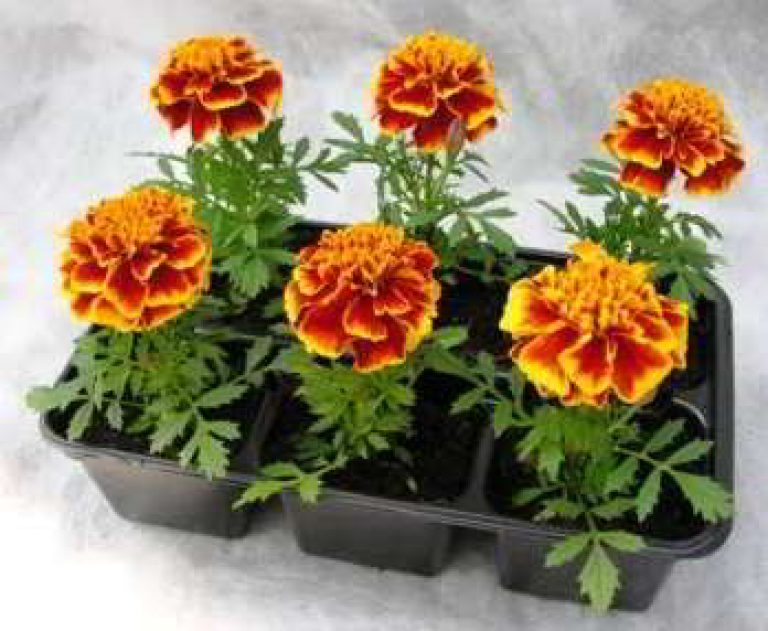
Description
Silverweed shrubby Red Ice (Potentilla fruticosa Red Ace) -
compact shrub round shape up to 0.6 m height and crown diameter up to 1 m. It blooms from June to October with small orange-red flowers up to 3 cm in diameter, which become more yellow during the hot dry summer, and they turn red in cool conditions. The leaves are light green, consisting of 3-7 lanceolate-ovate leaflets, up to 3 cm long. Drought resistant to soil unpretentious. Light-requiring, but tolerates with a little shading. Winter hardy It tolerates urban conditions.
| The size: | height is up to 0,6 m, diameter of krone is 1 m. |
|---|---|
| Bloom: | abundant, orange-red flowers up to 3 cm in diameter. |
| Foliage: | light green. The leaves are complex, consisting of 5 leaves 2-3 cm long, yellow in autumn. |
| Growth features: | fast growing, the annual increment is 15 cm in height and 20 cm in width. |
| The soil: | prefers light drained moist soils, from acidic to slightly alkaline pH 5.5 to 8.0 (see What is soil acidity: pH determination and regulation). |
| Shine: | sun, partial shade. In the penumbra with moist soil flower color more red. |
| Moisture: | to moisture demanding. |
| Frost resistance: | frost hardy Zone 3 (see Climate Zones). |
| Landing: | Landing in the pits 50-60 cm deep. Drainage is a layer of broken brick or pebbles 15-20 cm thick. Humus and sand are added to the existing garden soil. The root neck should be located at ground level. If the soil is poor, you can add mineral fertilizers by adding up to 100 g of complex fertilizer to each planting pit. |
| Care and protection: | Before flowering plants are fertilized. Once every 3-4 years in the second half of April, you can cut by 8-10 cm, to give the bush a compactness. In September, if necessary, carry out molding, pruning shoots 1/3 of the length. Potentilla tolerates a haircut well and keeps its decorative compact look for a long time (see Kinds of pruning of green plantings). |
| Purpose: | Single and group plantings, flower beds, borders, rock gardens, for growing in containers. |
Frost-resistant shrub from England, distinguished by the small size of the bush.
The diameter of the crown of an adult plant: 1m
Height of an adult plant: 0.6 m
Description
Potentilla shrub "Red Ice" - a small shrub (about 50-60 cm tall and up to 1 m in diameter). Light red flowers stand out against the background of light green foliage. Outside, the petals have a light orange shade. Flowering continues from June-July to October. Variety prefers moist half-shaded places, responsive to high humidity.
It is steady against smoke and gases, and, therefore, can be used without special problems in city conditions. Used by
Landing guide
With a dense group planting bushes are placed at a distance of 60-80 cm from one another. Landing in the pits 50-60 cm deep. Drainage is a layer of broken brick or pebbles 15-20 cm thick. Humus and sand are added to the existing garden soil. The root neck should be located at ground level. If the soil is poor, you can add mineral fertilizers by adding up to 100 g of complex fertilizer to each planting pit. Before flowering, the plants are fertilized: 30 g of superphosphate and 10 g of potassium sulfate are dissolved in 10 liters of warm water.
Care guide
Scrub the bushes once every three years. You can cut in September, in this case, shortened non-lignified shoots are cut by an average of one third. If the procedure occurred in April, the shoots should be shortened by approximately 10-20 cm, in the spring it causes active growth and branching. Potentilla tolerates a haircut and maintains its decorative compact look for a long time.

